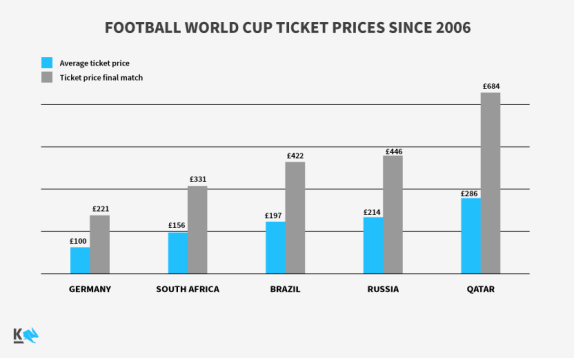Study reveals World Cup tickets more pricey than ever: Seats for Qatar 39% more expensive than in Russia 2018

An analysis of World Cup ticket prices over time shows how football fans have been asked to pay more and more with each World Cup since 2006.
A World Cup ticket in Qatar costs an average of £286. 39 % more than 2018 World Cup tickets.
Final match tickets cost around £684. A plus 59 % compared to the last World Cup.
Fingers crossed for a bargain on Euro 2024 tickets: Germany was the cheapest World Cup in the last 20 years.
Munich, Germany, 17th of November 2022 – The sports supplier Keller Sports has analysed World Cup ticket prices in various sports. The conclusion for football: The World Cup in Qatar is not only the most expensive World Cup of all time in terms of total costs, but also in terms of ticket prices.
A seat in the stadium is on average 39 % more expensive than during the last World Cup in Russia. Tickets for the grand final in Qatar cost 59% more than the final match in 2018.
The World Cup ticket prices for different stages in the tournament and price categories were researched and compared with the ticket prices of previous World Cups – Japan/ South Korea 2002, Germany 2006, South Africa 2010, Brazil 2014 and Russia 2018.
A ticket for the World Cup in Qatar is priced at an average of £286
At the time when the first Winter World Cup will start in Qatar, football fans from all over the world will have spent £286 on average for a seat in the stadium.
The cheapest matches are those in the group phase at the start of the tournament. In group B, England and Wales will face each other as well as Iran and the US. The first matches of England and Wales will take place on the 21st of November 2022. England plays against Iran. Wales faces the US. A spectator ticket for these matches cost fans around £93.
Fans could purchase tickets either through FIFA’s sales platform or through the FA or the WAF. Permission to buy tickets was raffled among those who registered.
On top of ticket prices come costs for travel, accommodation and meals during a major high season. For hotel rooms and accommodation, Qatar has installed a price cap for the period around the tournament. Hoteliers are allowed to charge a maximum of £103 per night for a 4-star accommodation.
As usual, ticket prices increase with each match towards the final. The most expensive tickets are for the World Cup’s final. Those who want to be part of the 80,000 spectators at the final match on 18 December 2022 in the Lusail Iconic Stadium will pay around £684.
This means tickets for the Doha final are more than 59% more expensive than the grand final tickets at the 2018 World Cup in Russia. Looking back, the cheapest host of a World Cup was Germany in 2006.






